If you grow roses, you might notice a soft white growth on their leaves, stems, and buds. This growth might appear if your roses grow in a damp, shady place.

This is a fungus called powdery mildew (Podosphaera pannosa). Once it appears, it can be hard to get rid of.
Read on to learn about what powdery mildew looks like, how it attacks your roses, and how to control the disease.
Jump to:
Fast Facts
| Common name: | Powdery mildew |
| Scientific name: | Podosphaera pannosa |
| Symptoms: | A white, powdery-looking fungus that coats leaves, stems, and flowers and cannot be rubbed off. Generally found only on the upper leaf surface. Leaves look warped and disfigured. Sometimes, there’s purple mottling. |
| Commonly seen: | Summer and fall |
What is Powdery Mildew and How Does it Affect My Roses?
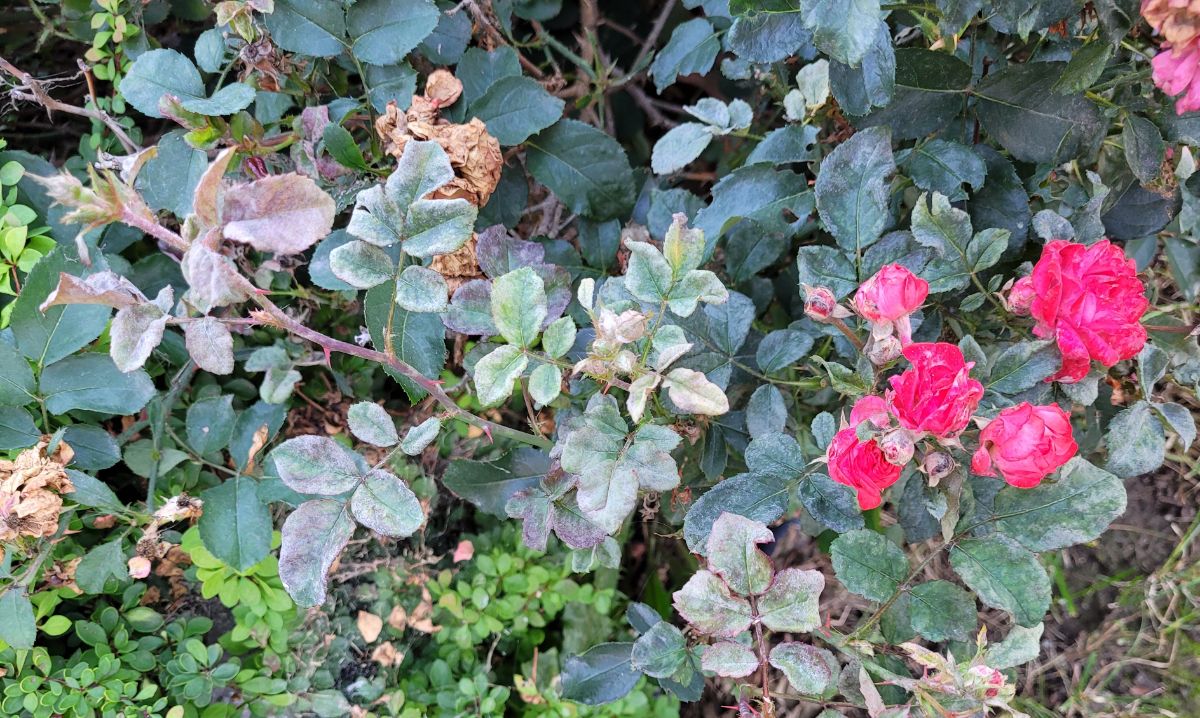
This widespread rose disease is caused by a fungus called Podosphaera pannosa (formerly named Sphaerotheca pannosa var. rosae – the change was made for complicated taxonomic reasons).
In its early stages, powdery mildew makes your plant look like it’s been dusted with flour or powdered sugar. If only this disease merely consisted of baking goods!
Powdery mildew is a parasite, obtaining nutrients from its living host (i.e., your rose). It starts as small powdery spots on the upper parts of leaves, then slowly spreads as a white or light-gray powder-like growth covering the leaf and other plant parts. As it grows, it penetrates the leaf surface to absorb nutrients.
When conditions are right, powdery mildew can cover the entire rose – leaves, stems, sepals, buds, and flowers. Young foliage often catches the disease first since it’s easier for the mildew to infect soft new growth.
Generally, powdery mildew does not kill off roses – but it can certainly make them unhealthy.
How Does Powdery Mildew Grow and Spread?
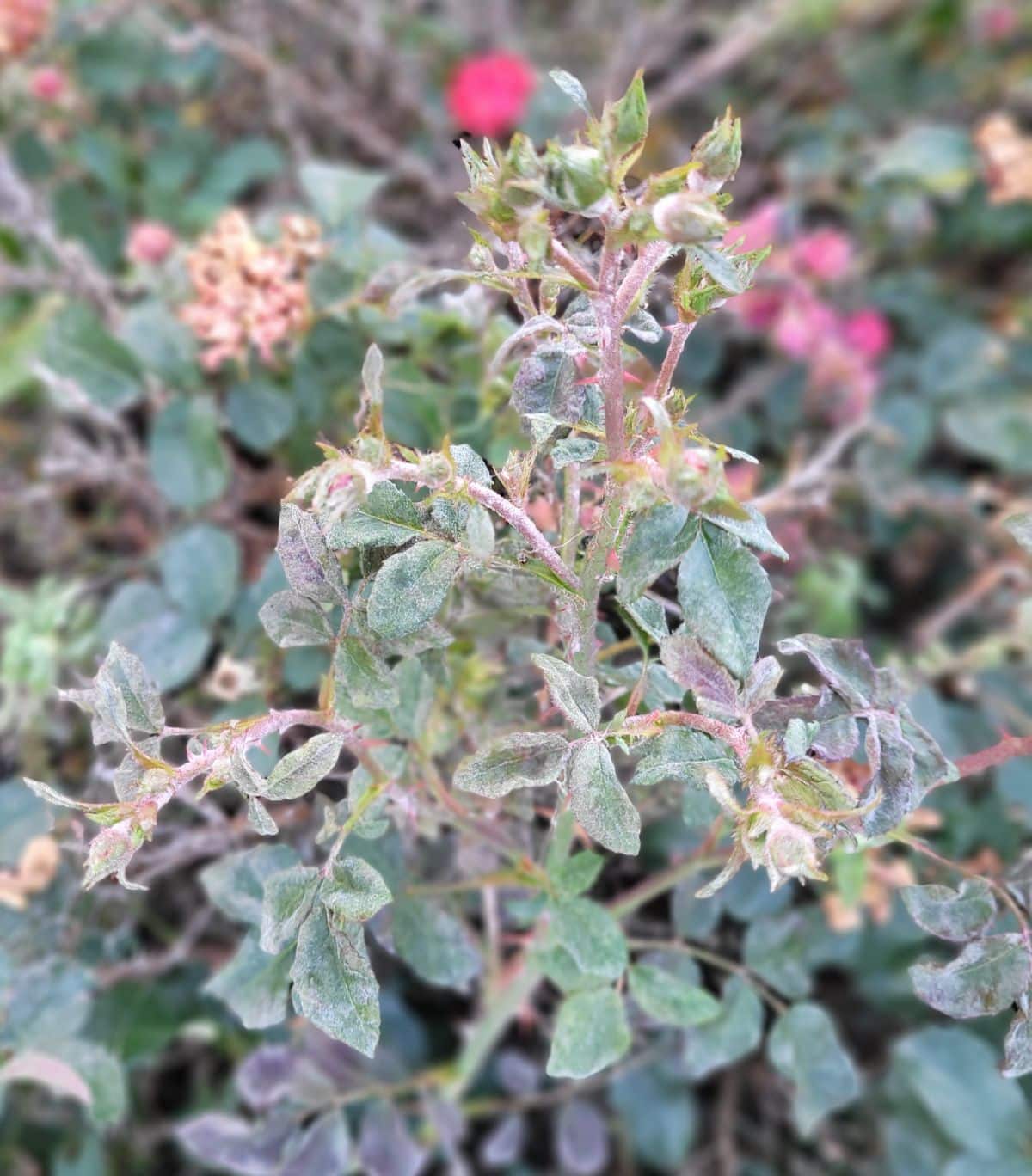
Unlike other mildew, this disease can infect roses when their leaf surfaces are dry because powdery mildew does not need water to germinate and spread.
Cool days and humid nights are ideal for its growth and spread, so it tends to appear toward the end of the gardening season. Powdery mildew slows down when temperatures rise above 90°F (32°C). Also, the fungus won’t spread in cool, rainy conditions (though its spores still spread).
Powdery mildew loves roses that are crowded together, roses growing in the shade, and areas with poor air circulation.
Once the disease gets established on a plant, it produces spores every 3-14 days, then releases them, infecting nearby roses.
Like black spot, another fungus that afflicts roses, their spores are spread by air currents and splashing water droplets (from rain or overhead watering). Spores are released in the greatest numbers in the middle of the day.
The ultraviolet light in sunlight kills fungal spores – so make sure your roses get sunlight every day.
Can Powdery Mildew Spread to Other Plants?
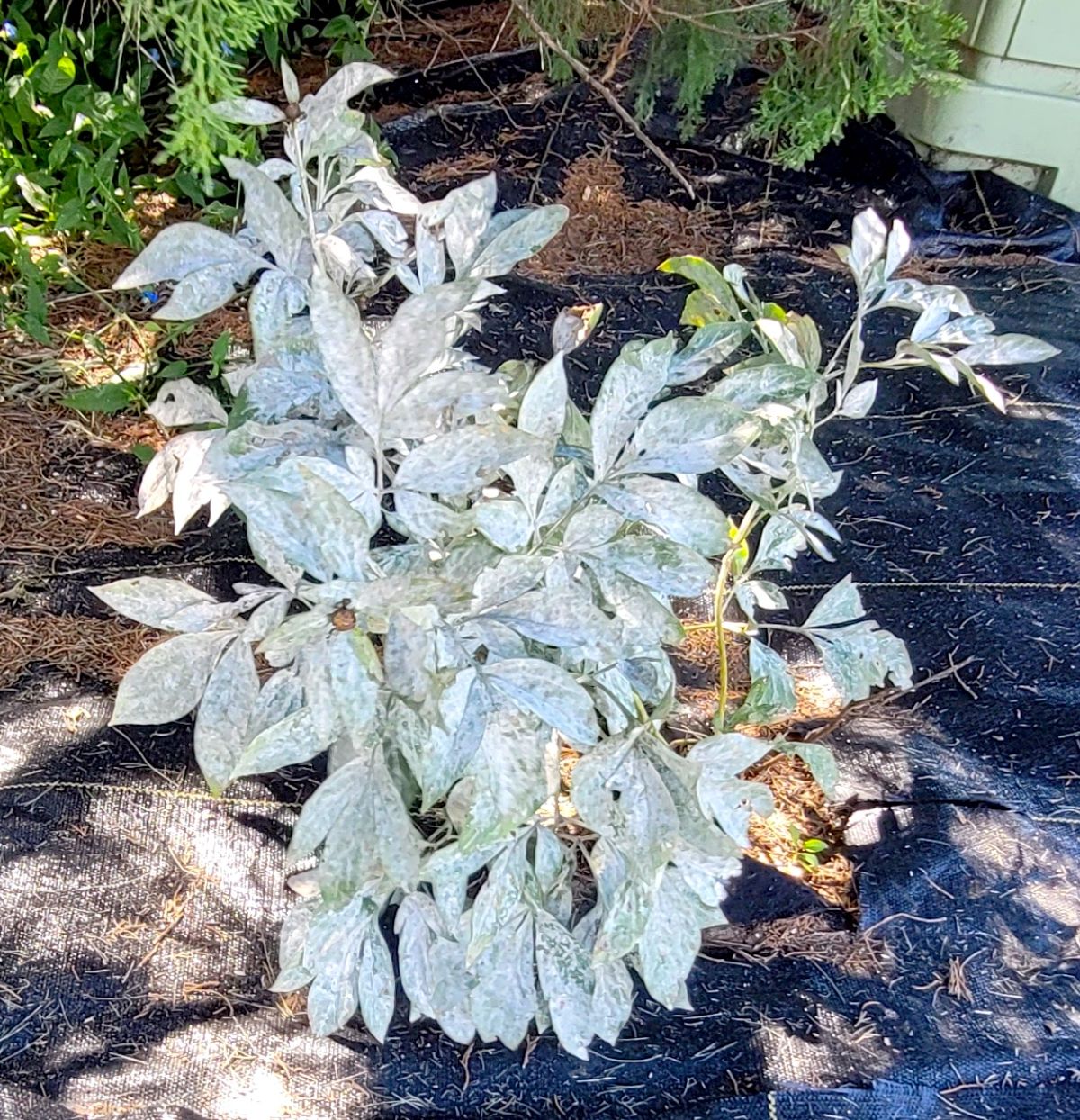
Powdery mildew is a common affliction on many plants across many plant families. This fungus consists of a lot of different species, such as Erysiphe spp., Blumeria graminis, Cystotheca, Microsphaera, and many others.
The good news: Each of these strains targets specific plants or groups of plants – so the powdery mildew on your roses won’t spread to your zucchini, peonies, bee balm, or phlox. Podosphaera pannosa will spread only to roses.
The bad news: All these plants will simply catch their own strains of powdery mildew, unfortunately!
The good news: The same controls that work for powdery mildew on roses will also work for other plants that have this disease. So read on.
Watch Out for Powdery Mildew Appearing in Fall
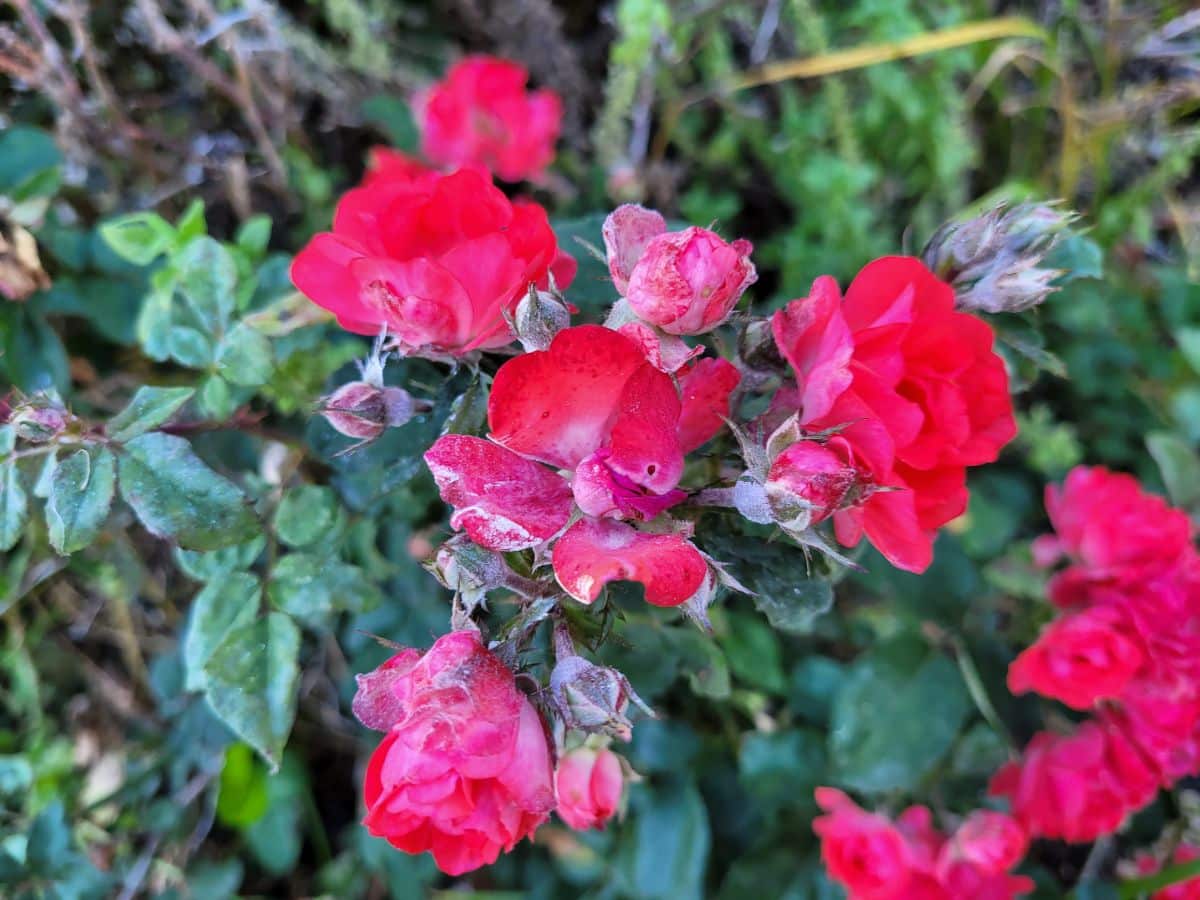
Powdery mildew often shows up at the end of the season, triggered by the cool nights and mild days of fall. Once you see the white fuzz appear on the leaves, fungicide likely won’t make it go away. At this point, the fungus has had time to spread across the leaf, and it’s planted its hyphae on the leaf’s surface. If you rub the leaf and the fungus stays put, that’s why.
Spraying will keep the spores from spreading, at least.
However, the best way to keep powdery mildew off your roses is through prevention.
Good news: The preventative measures that I’ll cover in the Controls section below will help keep powdery mildew at bay – and they will also prevent other rose diseases such as blackspot, rust, and downy mildew.
An ounce of prevention equals a ton of happy roses.
A Side Note

It’s okay to have a spot of disease once in a while on your roses and not pounce on it immediately.
Sometimes, it feels as if people in America have this mentality of utterly eradicating every disease or insect that rears its head. This interferes with people being able to simply enjoy their gardens because they’re out there waging this battle that doesn’t need to be fought.
You’re only one person dealing with a lot of things, both in the garden and outside of it. Don’t add to your stress if you don’t need to.
Total eradication of any disease or pest isn’t the goal here. The roses will be fine if there is a little powdery mildew or a few aphids.
Our goal is to keep pests and diseases manageable – and to enjoy ourselves out there.
Cultural Control
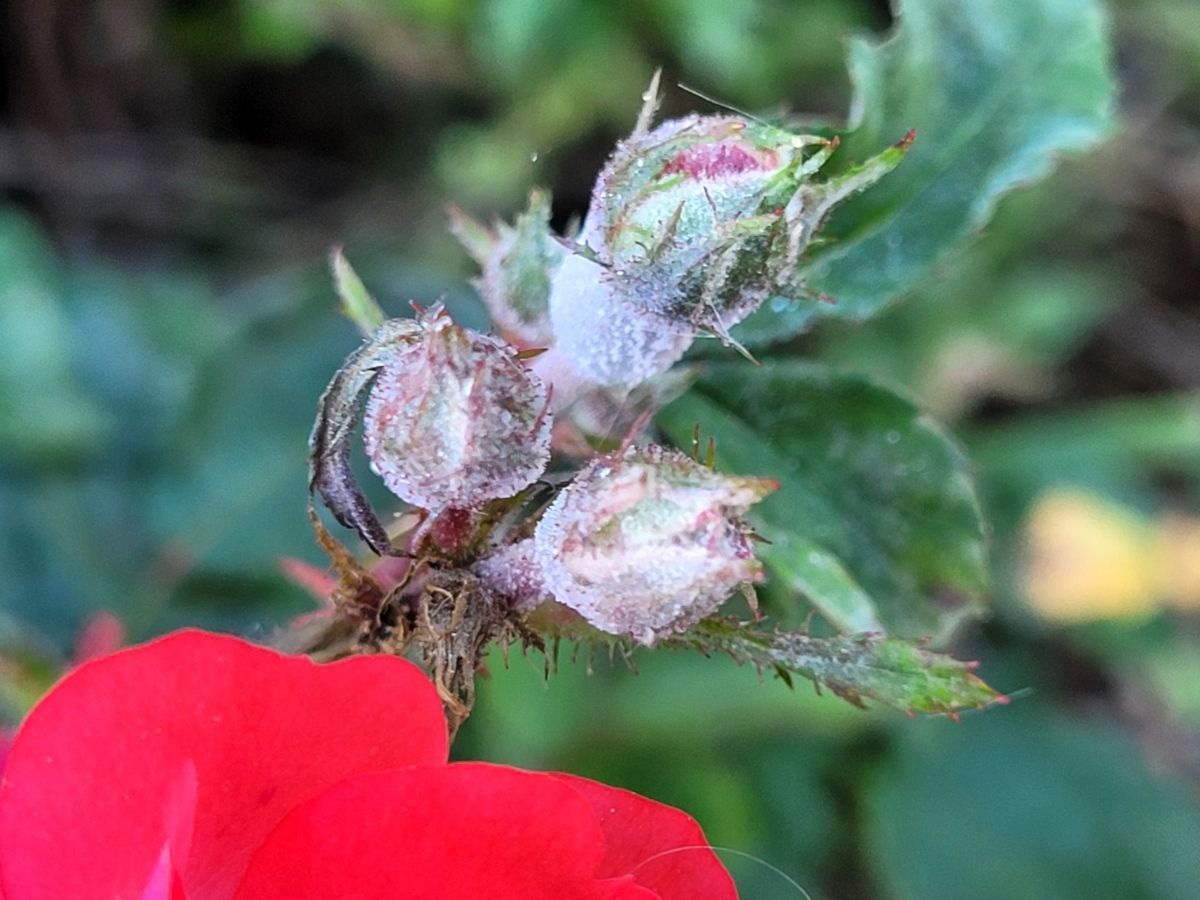
Most diseases or pest infestations can be controlled by good hygiene in the rose garden. Powdery mildew is no different.
Here are some guidelines that will help slow the spread of powdery mildew and get it out of your garden – along with other pesky diseases!
- Plant roses in full sun because UV light kills spores.
- When buying a rose, make sure it’s free from powdery mildew.
- Give roses space to grow so air circulates freely. This reduces humidity around the plants.
- Sterilize your pruners between roses. Use disinfectant wipes to rub them down or a rag dipped in a 9:1 solution of water with bleach. Rub them well to dislodge spores and other pathogens.
- Avoid overfertilizing, especially with nitrogen fertilizers. Nitrogen causes soft, green growth that’s tender and juicy for hungry pathogens like powdery mildew.
- As soon as you see infected leaves, clip them off and destroy them outside the garden. Don’t compost them. The same goes for any infected stems. This keeps the fungus from spreading its spores.
- Never clip or touch multiple roses when there’s water on them. Powdery mildew spores and other diseases are spread from rose to rose via the water drops on your hands and pruners.
- Remove fallen rose leaves from the garden.
- In late fall, mark the roses that have had powdery mildew. Clip off all leaves, cut off severely infected stems, and clean up fallen leaves and mulch around the roses. Then, spray the rose and the ground around it thoroughly with dormant oil. Once it dries, put fresh mulch around the roses.
- When you do your early spring pruning, clip back these roses separately from the others. Do your regular pruning, and get the canes out of the garden.
Eco-Friendly Chemical Control
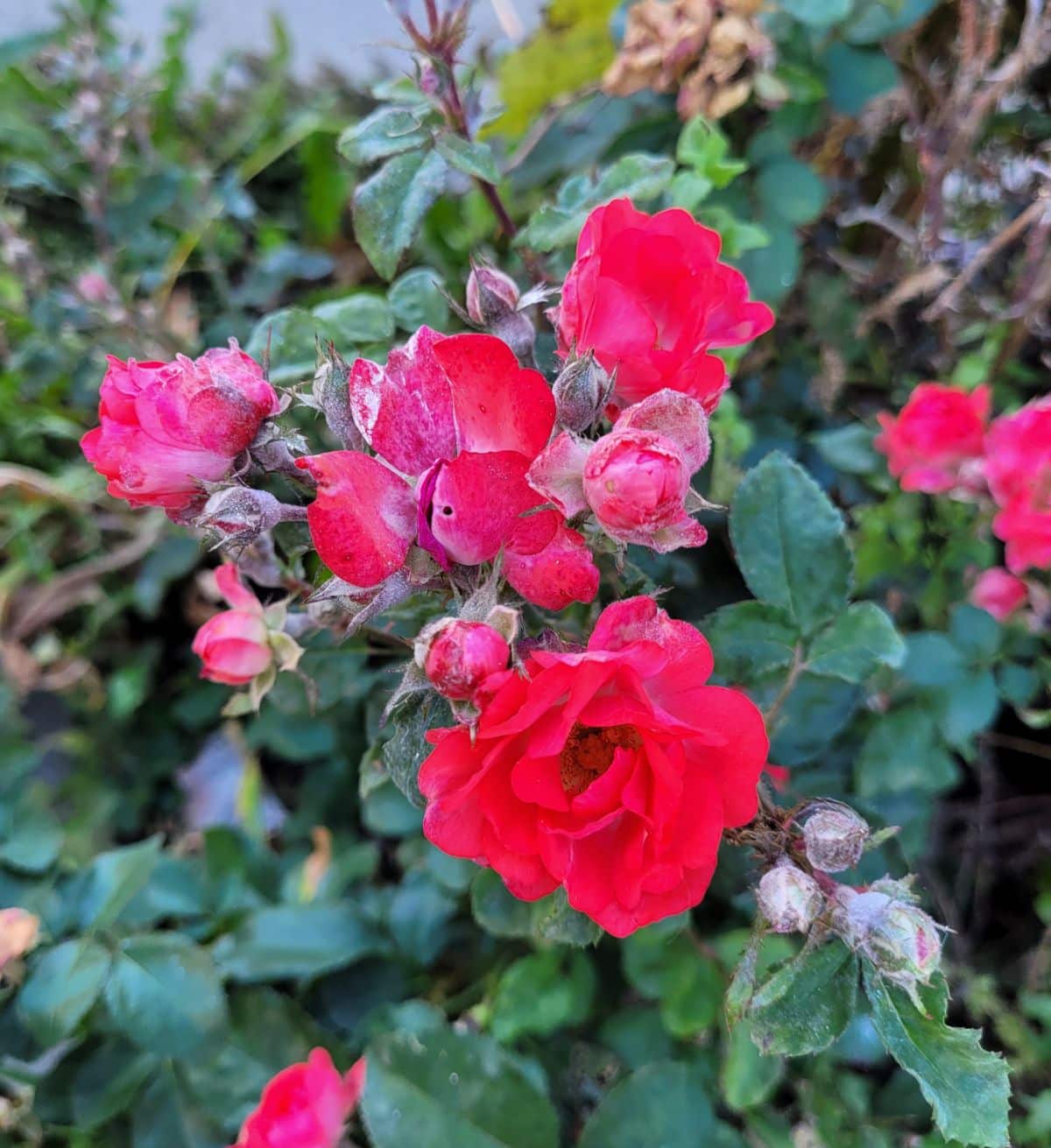
When I was a horticulturist running a rose garden with over 300 roses, I did my best to take it easy on chemical controls. I always followed label directions, I used only as much as I needed, and I sprayed only what needed spraying.
And – this is most important – don’t rely on sprays to do all the work for you.
These are preventative fungicides, so they’ll need to be sprayed twice a month on your roses all through the growing season.
Spray one of these about twice a month (according to label instructions!!) to prevent powdery mildew, blackspot, and other fungal diseases. Preventative spraying mixed with the cultural controls above will give you the best results.
Neem oil, obtained from the seeds of the neem tree, is a natural fungicide and is very successful at killing powdery mildew spores, along with other diseases.
Some neem oil solutions available contain potassium bicarbonate, or they might contain sulfur, making them effective for blackspot prevention as well.
Neem oil breaks down quickly in the environment, making it a safe choice for the garden. Choose pure neem oil concentrate to avoid any surprise non-organic ingredients.
Sulfur-based fungicides are effective, have low toxicity, and have been used for over a hundred years as a fungicide on roses, grapes, and other plants.
But remember!
Don’t use sulfur products if you’ve applied an oil spray in the last 31 days.
Spray only when temperatures are under 80°F (26°C) to avoid plant injury.
Lime sulfur was my go-to fungicide for all-season rose care until the EPA banned it in the United States.
Bordeaux mixture targets fungus and bacteria, so it can help your roses but can also stop leaf spot and apple scabs on your fruit trees and grape vines, along with other diseases.

Potassium bicarbonate is similar to sodium bicarbonate (baking soda), except it doesn’t have sodium. It’s extremely effective against powdery mildew and other fungal diseases. It pulls the moisture out of the fungus and causes the cell walls to collapse.
For some reason, in the United States, it’s kind of hard to find potassium bicarbonate labeled and sold as a fungicide in anything under a 5-pound bag. However, if you have a lot of roses, grapevines, stone and pome fruit, and vegetable plants that are afflicted with powdery mildew and you want to keep your gardening non-toxic, a 5-pound bag of potassium bicarbonate would work very well.
For those who only need just a pound of potassium bicarbonate, it’s available for brewing and breadmaking and is the same stuff you see in the 5-pound bag, except without the spreader stickers.
To make a homemade solution, use:
- 1 tablespoon potassium bicarbonate
- 1 tablespoon horticultural oil
- ½ teaspoon of castile soap (peppermint is nice)
- 1-gallon water
Mix them together in a gallon sprayer and spray both sides of the leaves. Shake the sprayer often to keep the solution mixed. Spray only in cool or overcast weather to avoid leaf scald.
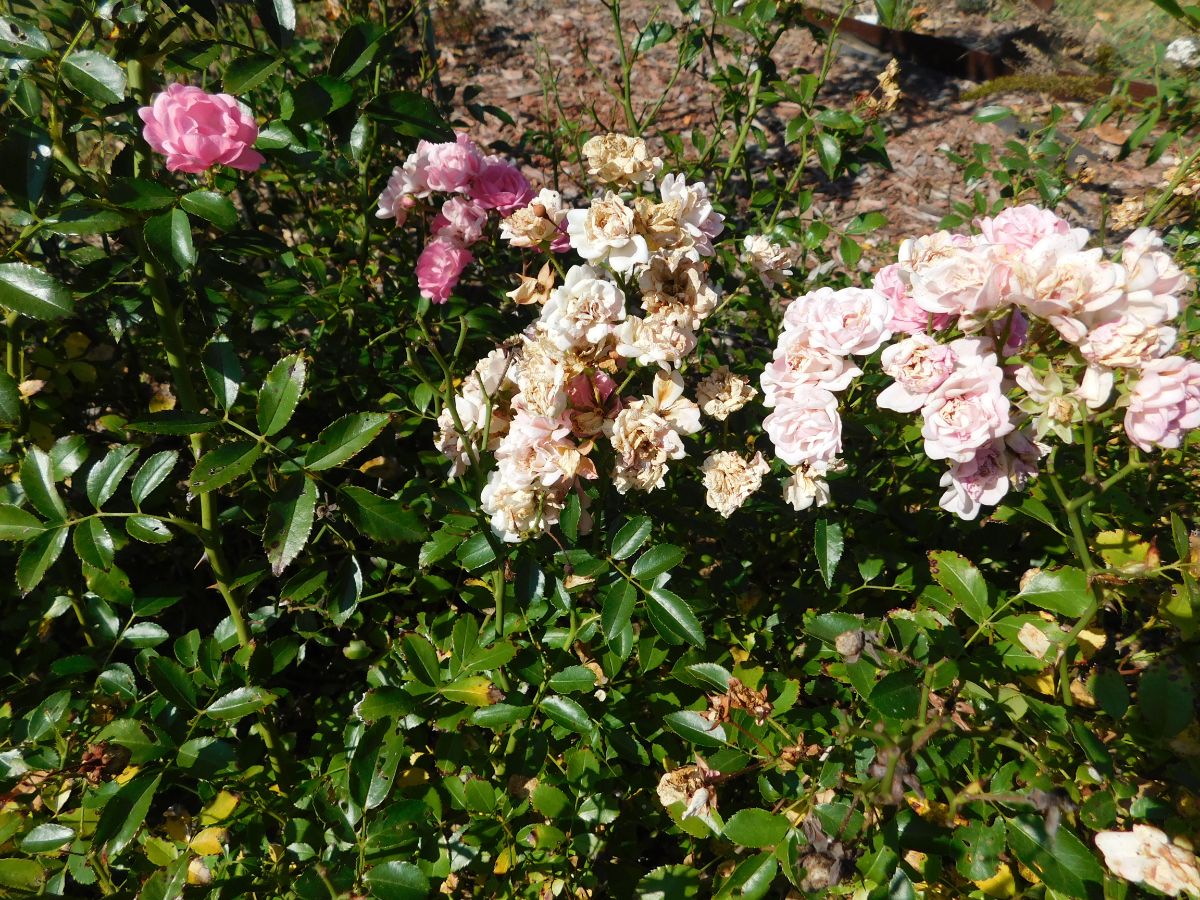
If you can’t get your hands on potassium bicarbonate, you can use sodium bicarbonate (baking soda) mixed with horticultural oil instead.
- 4 teaspoons of baking soda
- 1 tablespoon of all-season horticultural oil
- 1 gallon of water
Spray only during cool weather to avoid problems. Shake the sprayer often while you’re spraying to keep the oil and water mixed.
With baking soda, spray lightly, not to the point of runoff. If it reaches the soil in drought-stressed areas, sodium bicarbonate can slowly accumulate in the soil, leading to slower plant growth and, eventually, to chlorosis. In areas with normal rainfall that flushes out the soil, this isn’t a problem.
Anti-transpirants, such as Wilt-Pruf, Cloud Cover, or Bonide Anti-Wilt, are very helpful as a preventative measure against powdery mildew and other diseases that affect leaves.
Spray roses with an anti-transpirant in spring once the foliage is formed. This will stop water loss in your roses (which is helpful when there’s a drought), and it forms a waxy barrier that keeps out disease spores. It also makes your rose leaves very pretty and lustrous!
When the leaves lose their luster, spray the anti-transpirant again.
Don’t spray your roses with anything else for about two or three weeks after you spray the anti-transpirant.
A Few Roses That Are Resistant to Powdery Mildew
Planting resistant roses is also important to keep powdery mildew down. Often, roses with glossy foliage are more resistant to fungal diseases.
We’ll have an article about powdery mildew-resistant roses soon, but a few of the best include any of the roses bred by Dr. Griffith Buck, including William Baffin (this rose is a tank) and Quietness. Rugosa roses tend to be very disease-resistant in general. Earth Kind roses can thrive on neglect.
Do you have any questions about powdery mildew? How have you dealt with powdery mildew in your garden? Let us know in the comments below.

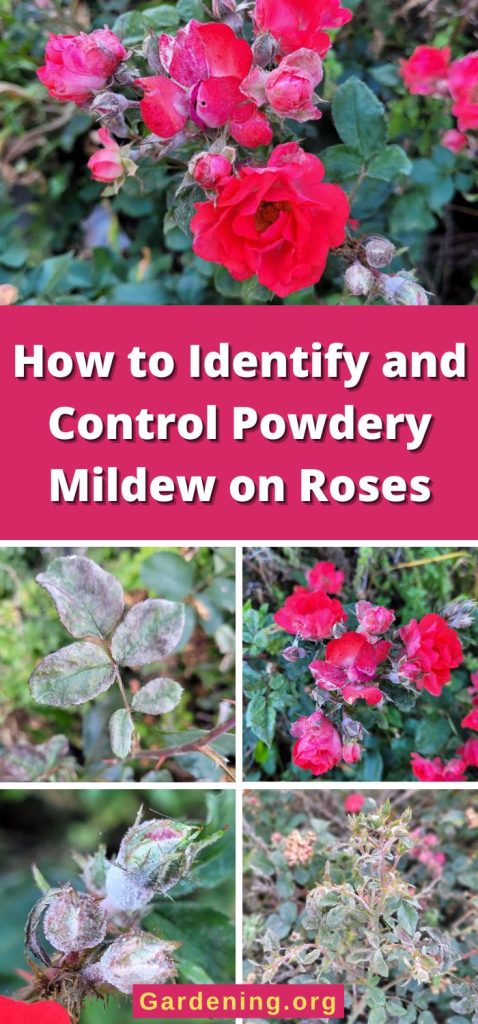
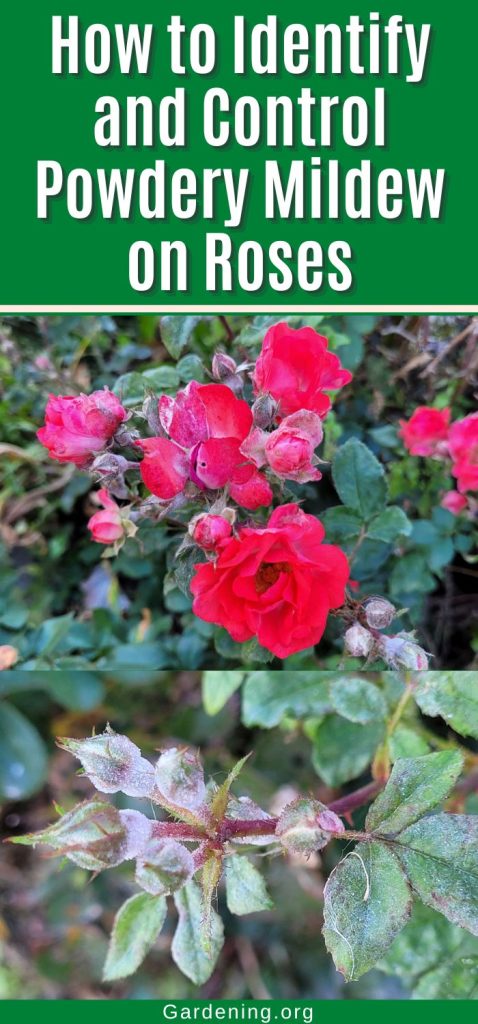
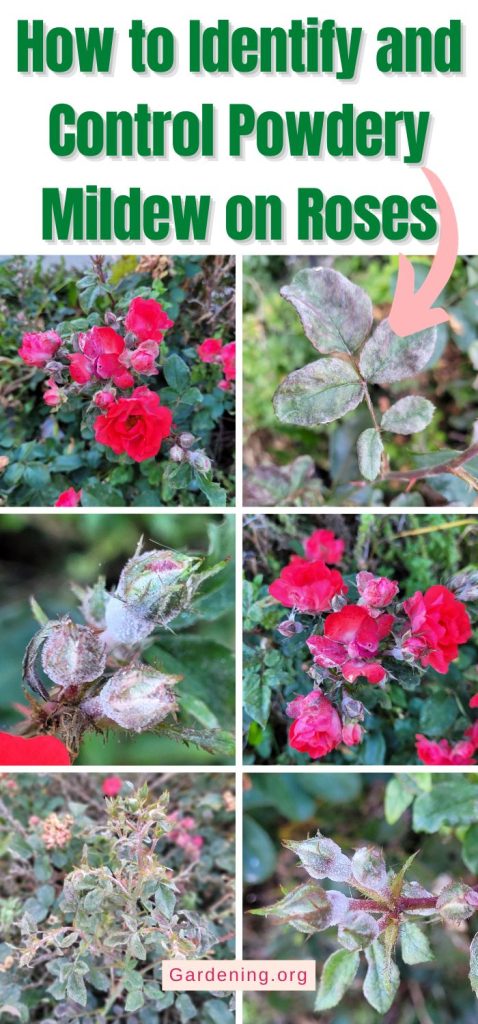
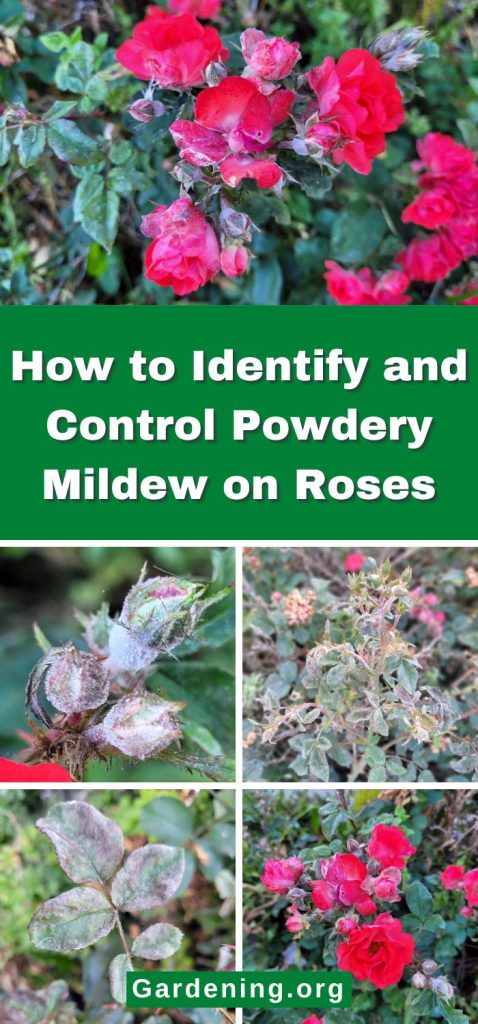
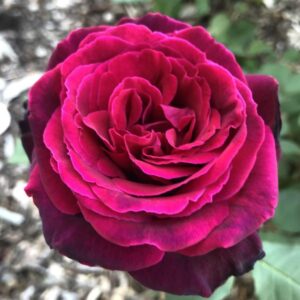



Leave a Reply